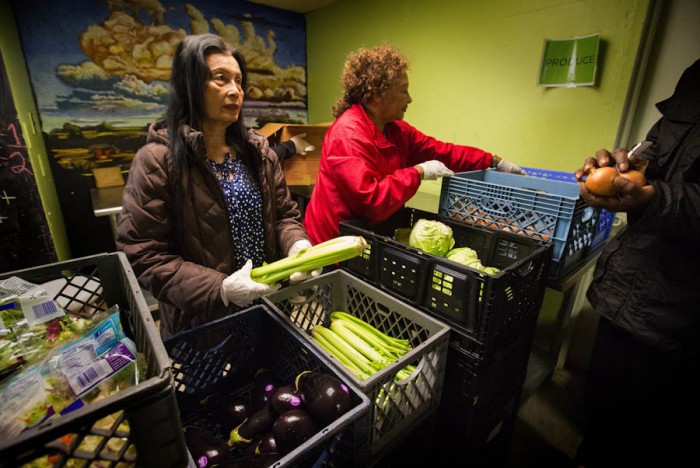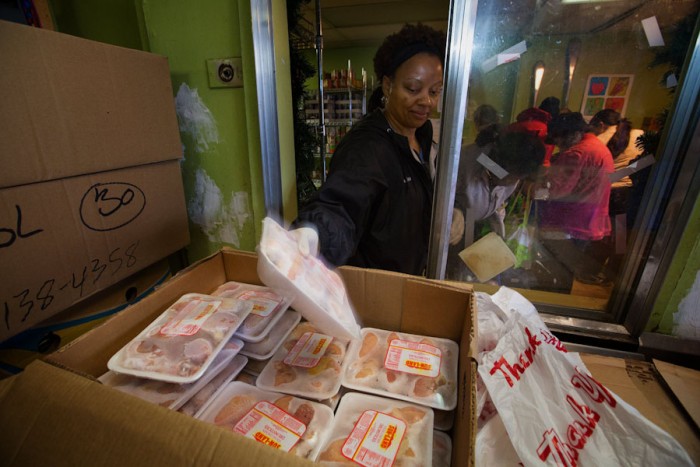
A year ago, the 24-year-old Rainier Valley Food Bank was at a breaking point. Need had climbed steadily for five years, food donations were down and an increasingly international clientele meant more potential for cultural and linguistic barriers than ever before.
For Sam Osborne, Executive Director, the “meat station” — a half busted, chest freezer piled high with frozen meat for distribution — was a metaphor for the entire strained operation.
“People would…be pushing and pushing and pushing to get to the meat,” says Osborne explaining that food bank guests — eager to get to the most sought after item — would skip over produce and grains in a rush toward what looked like a diminishing pile of meat, “You could feel the tension in here — it was palpable.”
They needed a system, one that maximized efficiency, speed and customer service but required very few resources. Osborne found that system in Kaizen, a corporate philosophy from Japan that emphasizes “continuous improvement” through small “good changes” (the literal translation of the word).
Through a board member Osborne was able to access the “Continuous Improvement” team at Starbucks (the company has used the Kaizen approach for years) and Kaizen experts were dispatched to the Food Bank to observe processes and help address problems.
The meat station chaos sparked a series of questions, or, what Whitney Law — a “continuous improvement manager” at Starbucks who works with the Food Bank — calls “humble inquiry.”
Why was meat stocked on top of the freezer? The ancient and finicky freezer would break if overused by guests serving themselves.
Why did its position at the back of the warehouse stress guests out? They could see others taking meat while they waited and worried there would be none left for them.

Using that information the food bank began to experiment with different locations for the meat station, ultimately dispensing of the old chest freezer entirely in favor of a walk in freezer and service window at the front of the warehouse. This meant guests could see the meat right away and get served in an orderly manner.
This may seem insignificant, but little “kaizens” like this really add up says Osborne, who estimates that moving the meat station alone saved every guest 45 seconds. A significant gain when multiplied by the 583 people who passed through the 1,200-square-foot warehouse last Saturday.
“They were able to go to their mind instead of their wallets,” says Law, explaining that the Food Bank had initially thought they needed to fundraise for a new freezer.
After the meat victory, the Kaizen team took on other “choke points” including the produce station (where they now allow people to pick their own produce). In a year they were able to reduce wait times at the Food Bank by more than half.
“Before…when we [served] over 450 people we’d be open until 3:30, 4:00, 4:30, 5:00,” says Osborne in a cramped office decorated with humorous items that have been donated over the years (including 26-year-old muffin mix and a box of something called “drinking gelatin”), “Now we can get that many through and be done not just at 2:00, but before 2:00.”
And while reducing wait times is important to the Food Bank, so is improving the overall experience for guests. This can be particularly challenging with guests from other countries who may already be scared to seek help, intimidated by the bureaucracy of another country or even just confused by a different culture of “queuing.”
“[Kaizen is] actually allowing us to serve each of our guests more directly and it means a lot to us because we have these challenges of translating culturally and linguistically” says Food Bank Resource Development Coordinator Miguel Jimenez, before rattling off a list of at least two dozen languages spoken by Food Bank guests.
Osborne says their new transparent and standardized system has cut down on confusion and stress for English speaking and non-English speaking guests alike. An important goal when you’re serving people already going through a tough time.
“It’s hard enough to get here,” says Osborne “we want it to be easy as possible once you do.”
A goal the Rainier Valley Food Bank is accomplishing one Kaizen at a time.


Sarah, thanks for such an interesting piece! From my time working at a food bank, I know the central focus of staff and operations is almost always on how to get more food, how to get more staff, how to get more money — all of which there is never enough of. It is embedded deeply within the nonprofit industrial complex which relies on concentrated wealth (donors) to address the patching up of poverty, along with western/white workplace norms of running the operating. It doesn’t push us to think about creative ways of solving these problems. Other workplace philosophies, esp. those that don’t favor productivity and efficiency above all else, are often snubbed or overlooked, yet western places of work still manage to be profoundly wasteful. Kaizen seems to continue to favor efficiency for the service being provided, while tapping into a deeper well of integrated knowledge and resource sharing that benefits everyone. It reminds me of mis-en-place, in cooking. I’m happy to see it in practice at the RVFB food bank. I just hope that corporate America doesn’t do with this idea what gentrified America has done with yoga — taken an global/eastern philosophy and used it to support the very western ideals of capitalism and production.